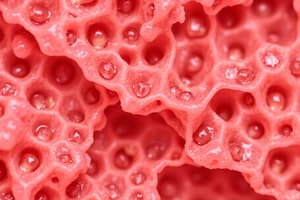Podcast
Questions and Answers
What is a tissue?
What is a tissue?
A group of cells that are similar in structure and/or work together to achieve a particular function.
Which organism types are mentioned regarding their tissues?
Which organism types are mentioned regarding their tissues?
- Bacteria
- Fungi
- Animals (correct)
- Plants (correct)
Plants are stationary and do not move.
Plants are stationary and do not move.
True (A)
What type of tissues do plants primarily have?
What type of tissues do plants primarily have?
How do animal tissues differ in terms of growth compared to plant tissues?
How do animal tissues differ in terms of growth compared to plant tissues?
Match the following types of tissues with their characteristics:
Match the following types of tissues with their characteristics:
Flashcards are hidden until you start studying
Study Notes
Overview of Tissues
- Living organisms consist of cells; unicellular organisms perform all functions with a single cell, like Amoeba.
- Multi-cellular organisms have specialized cells with distinct functions, resulting in efficiency.
- Different cells in multi-cellular organisms work together to carry out specific functions, forming tissues.
Comparison between Plants and Animals
- Plants are stationary and primarily consist of supportive tissues that provide structural strength.
- Many plant tissues are composed of dead cells, which can provide mechanical support with minimal maintenance.
- Animals are mobile and consume more energy, leading to the predominance of living tissues that require maintenance.
Growth Patterns
- Plant growth occurs in specific regions, limiting division to meristematic tissues.
- Animals exhibit more uniform growth with no distinct dividing regions, allowing for continuous cell growth.
Tissue Classification
- Plant tissues are categorized into:
- Meristematic tissue: Actively dividing cells.
- Permanent tissue: Non-dividing cells with specialized functions.
- Examples of animal tissues include blood, muscle, and nerve tissues, each designed to achieve specific tasks.
Specialization and Structural Organization
- Complex animals have highly specialized and localized organ systems compared to complex plants.
- The structural organization of tissues is vital for the efficiency of functions in both groups of organisms.
Functional Adaptation
- Distinct adaptations reflect different feeding methods and lifestyles; plants have a sedentary existence, while animals rely on locomotion.
- The differences in tissue structure and organization are closely linked to the environmental and functional needs of the organisms.
Studying That Suits You
Use AI to generate personalized quizzes and flashcards to suit your learning preferences.



